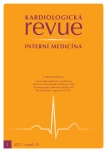Cardiotoxicity of anti-cancer drugs in experimental settings
Authors:
M. Adamcová 1; M. Štěrba 2
Authors‘ workplace:
Ústav fyziologie, LF UK v Hradci Králové
1; Ústav farmakologie, LF UK v Hradci Králové
2
Published in:
Kardiol Rev Int Med 2017, 19(1): 11-13
Overview
This review article analyses the contribution of experimental research to the understanding of anti-cancer drug cardiotoxicity mechanisms and the options for cardioprotection. We focused on drugs inducing direct toxicity against cardiomyocytes resulting in left ventricular dysfunction. Typical features of Type I and Type II toxicity (represented by anthracyclines and trastuzumab/sunitinib, respectively) are discussed. The paper also describes in vivo models for experimental study of anthracycline cardiotoxicity.
Keywords:
mechanisms of cardiotoxicity – experimental models – anthracyclines – kinase inhibitors
Sources
1. Ewer MS, Ewer SM. Cardiotoxicity of anticancer treatments. Nat Rev Cardiol 2015; 12(9): 547 – 558. doi: 10.1038/ nrcardio.2015.65.
2. Štěrba M, Popelová O, Vávrová A et al. Oxidative stress, redox signaling, and metal chelation in anthracycline cardiotoxicity and pharmacological cardioprotection. Antioxid Redox Signal 2013; 18(8): 899 – 929. doi: 10.1089/ ars.2012.4795.
3. Zhang S, Liu X, Bawa-Khalfe T et al. Identification of the molecular basis of doxorubicin-induced cardiotoxicity. Nat Med 2012; 18(11): 1639 – 1642. doi: 10.1038/ nm.2919.
4. Pondé NF, Lambertini M, de Azambuja E. Twenty years of anti-HER2 therapy-associated cardiotoxicity. ESMO Open 2016; 1(4): e000073.
5. Chu TF, Rupnick MA, Kerkela R et al. Cardiotoxicity associated with tyrosine kinase inhibitor sunitinib. Lancet 2007; 370(9604): 2011 – 2019.
6. Chintalgattu V, Rees ML, Culver JC et al. Coronary microvascular pericytes are the cellular target of sunitinib malate-induced cardiotoxicity. Sci Transl Med 2013; 5(187): 187ra69. doi: 10.1126/ scitranslmed.3005066.
7. Robert J. Long-term and short-term models for studying anthracycline cardiotoxicity and protectors. Cardiovasc Toxicol 2007; 7(2): 135 – 139.
8. Maral R, Bourat G, Ducrot R et al. Toxicologic study and experimental antitumor activity of rubidomycin (13,057 R.P.). Pathol Biol 1967; 15(19): 903 – 908.
9. Gersl V, Cerman J, Suba P et al. IGF-I in experimental daunorubicin-induced cardiomyopathy in rabbits. Human Exp Toxicol 1999; 18(3): 154 – 161.
10. Adamcova M, Gersl V, Hrdina R et al. Cardiac troponin T as a marker of myocardial damage caused by antineoplastic drugs in rabbits. J Cancer Res Clin Oncol 1999; 125(5): 268 – 274.
11. Adamcova M, Lencova-Popelova O, Jirkovsky Eet al. Experimental determination of diagnostic window of cardiac troponins in the development of chronic anthracycline cardiotoxicity and estimation of its predictive value. Int J Cardiol 2015; 201 : 358 – 367. doi: 10.1016/ j.ijcard.2015.07.103.
12. Herman EH, el-Hage AN, Ferrans VJ et al. Comparison of the severity of the chronic cardiotoxicity produced by doxorubicin in normotensive and hypertensive rats. Toxicol Appl Pharmacol 1985; 78(2): 202 – 214.
13. Desai VG, Herman EH, Moland CL et al. Development of doxorubicin-induced chronic cardiotoxicity in the B6C3F1 mouse model. Toxicol Appl Pharmacol 2013; 266(1): 109 – 121. doi: 10.1016/ j.taap.2012.10.025.
Labels
Paediatric cardiology Internal medicine Cardiac surgery CardiologyArticle was published in
Cardiology Review

2017 Issue 1
Most read in this issue
- Diuretics and mineralocorticoid receptor antagonists in the therapy of chronic heart failure with reduced left ventricular ejection fraction
- COSYREL – a drug for patients with coronary artery disease and heart failure
- Rivaroxaban – pharmacological profile
- Late consequences of cardiotoxicity
